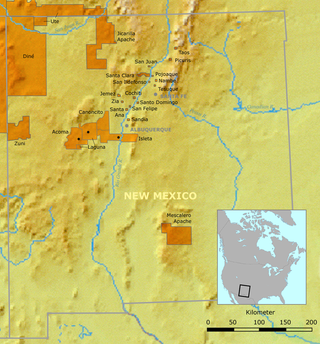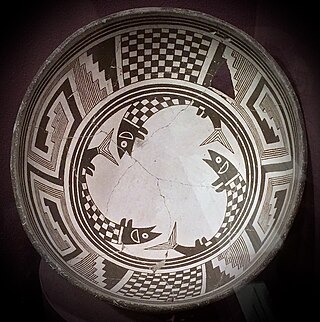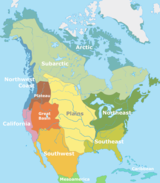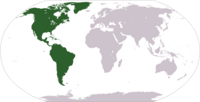
The Puebloans, or Pueblo peoples, are Native Americans in the Southwestern United States who share common agricultural, material, and religious practices. Among the currently inhabited Pueblos, Taos, San Ildefonso, Acoma, Zuni, and Hopi are some of the most commonly known. Pueblo people speak languages from four different language families, and each Pueblo is further divided culturally by kinship systems and agricultural practices, although all cultivate varieties of corn (maize).

The Southwestern United States, also known as the American Southwest or simply the Southwest, is a geographic and cultural region of the United States that includes Arizona and New Mexico, along with adjacent portions of California, Colorado, Nevada, Oklahoma, Texas, and Utah. The largest cities by metropolitan area are Phoenix, Las Vegas, El Paso, Albuquerque, and Tucson. Before 1848, in the historical region of Santa Fe de Nuevo México as well as parts of Alta California and Coahuila y Tejas, settlement was almost non-existent outside of Nuevo México's Pueblos and Spanish or Mexican municipalities. Much of the area had been a part of New Spain and Mexico until the United States acquired the area through the Treaty of Guadalupe Hidalgo in 1848 and the smaller Gadsden Purchase in 1854.

Hohokam was a culture in the North American Southwest in what is now part of south-central Arizona, United States, and Sonora, Mexico. It existed between 300 and 1500 CE, with cultural precursors possibly as early as 300 BCE. Archaeologists disagree about whether communities that practiced the culture were related or politically united. According to local oral tradition, Hohokam societies may be the ancestors of the historic Akimel and Tohono Oʼodham in Southern Arizona.

The classification of the Indigenous peoples of the Americas is based upon cultural regions, geography, and linguistics. Anthropologists have named various cultural regions, with fluid boundaries, that are generally agreed upon with some variation. These cultural regions are broadly based upon the locations of the Indigenous peoples of the Americas from early European and African contact beginning in the late 15th century. When Indigenous peoples have been forcibly removed by nation-states, they retain their original geographic classification. Some groups span multiple cultural regions.
Indigenous peoples of Arizona are the Native American people who currently live or have historically lived in what is now the state of Arizona. There are 22 federally recognized tribes in Arizona, including 17 with reservations that lie entirely within its borders. Reservations make up over a quarter of the state's land area. Arizona has the third largest Native American population of any U.S. state.

Mogollon culture is an archaeological culture of Native American peoples from Southern New Mexico and Arizona, Northern Sonora and Chihuahua, and Western Texas. The northern part of this region is Oasisamerica, while the southern span of the Mogollon culture is known as Aridoamerica.

The Sinagua were a pre-Columbian culture that occupied a large area in central Arizona from the Little Colorado River, near Flagstaff, to the Verde River, near Sedona, including the Verde Valley, area around San Francisco Mountain, and significant portions of the Mogollon Rim country, between approximately 500 and 1425 CE.

Oasisamerica is a cultural region of Indigenous peoples in North America. Their precontact cultures were predominantly agrarian, in contrast with neighboring tribes to the south in Aridoamerica. The region spans parts of Northwestern Mexico and Southwestern United States and can include most of Arizona and New Mexico; southern parts of Utah and Colorado; and northern parts of Sonora and Chihuahua. During some historical periods, it might have included parts of California and Texas as well.

This is a timeline of in North American prehistory, from 1000 BC until European contact.
Southwestern archaeology is a branch of archaeology concerned with the Southwestern United States and Northwestern Mexico. This region was first occupied by hunter-gatherers, and thousands of years later by advanced civilizations, such as the Ancestral Puebloans, the Hohokam, and the Mogollon.

The Point of Pines Sites are a set of archaeological sites on the San Carlos Apache Indian Reservation in the U.S. state of Arizona. Located around the settlement of Point of Pines, they are significant for associations with Ancestral Pueblo, Mogollon and Hohokam cultures. The sites were chosen as a field school location by Dr. Emil Haury because of the unusual presence of all three major prehistoric cultures of Arizona. The field school ran from 1946 to 1960, collecting large amounts of evidence from numerous sites. The site were collectively declared a National Historic Landmark in 1964.

Huápoca is an archaeological site located 36 kilometers west of Ciudad Madera, in the Huápoca Canyon region, northwest of the Mexican state of Chihuahua.
La Pintada is an archaeological site located some 60 kilometers south of the city of Hermosillo, Sonora, Mexico, within the "La Pintada" canyon, part of the "Sierra Libre", a small mountain massif of the coastal plains that extends throughout the Sonoran Desert.

Hundreds of Ancestral Puebloan dwellings are found across the American Southwest. With almost all constructed well before 1492 CE, these Puebloan towns and villages are located throughout the geography of the Southwest.

The Pueblo V Period is the final period of ancestral puebloan culture in the American Southwest, or Oasisamerica, and includes the contemporary Pueblo peoples. From the previous Pueblo IV Period, all 19 of the Rio Grande valley pueblos remain in the contemporary period. The only remaining pueblo in Texas is Ysleta del Sur Pueblo, and the only remaining pueblos in Arizona are maintained by the Hopi Tribe. The rest of the Pueblo IV pueblos were abandoned by the 19th century.

Art of the American Southwest is the visual arts of the Southwestern United States. This region encompasses Arizona, New Mexico, and parts of California, Colorado, Nevada, Texas, and Utah. These arts include architecture, ceramics, drawing, filmmaking, painting, photography, sculpture, printmaking, and other media, ranging from the ancient past to the contemporary arts of the present day.

The agricultural practices of the Native Americans inhabiting the American Southwest, which includes the states of Arizona and New Mexico plus portions of surrounding states and neighboring Mexico, are influenced by the low levels of precipitation in the region. Irrigation and several techniques of water harvesting and conservation were essential for successful agriculture. To take advantage of limited water, the southwestern Native Americans utilized irrigation canals, terraces (trincheras), rock mulches, and floodplain cultivation. Success in agriculture enabled some Native Americans to live in communities which numbered in the thousands as compared to their former lives as hunter-gatherers in which their bands numbered only a few dozen.

The Ancestral Puebloans, also known as the Anasazi, were an ancient Native American culture that spanned the present-day Four Corners region of the United States, comprising southeastern Utah, northeastern Arizona, northwestern New Mexico, and southwestern Colorado. They are believed to have developed, at least in part, from the Oshara tradition, which developed from the Picosa culture. The people and their archaeological culture are often referred to as Anasazi, meaning "ancient enemies", as they were called by Navajo. Contemporary Puebloans object to the use of this term, with some viewing it as derogatory.
The Puebloans of the southwestern United States and northern Mexico are descended from various peoples who had settled in the area, and shaped by the arrival of Spanish colonizers led by Juan de Oñate at the end of the 16th Century. There are three primary cultures: Mogollon, Hohokam and Ancestral Puebloen. They developed significant buildings and culture prior to European contact. After contact, they revolted in 1675 against the Spanish. The Puebloan culture is prevalent in the Southwest today.

Pueblo pottery are ceramic objects made by the Indigenous Pueblo people and their antecedents, the Ancestral Puebloans and Mogollon cultures in the Southwestern United States and Northern Mexico. For centuries, pottery has been central to pueblo life as a feature of ceremonial and utilitarian usage. The clay is locally sourced, most frequently handmade, and fired traditionally in an earthen pit. These items take the form of storage jars, canteens, serving bowls, seed jars, and ladles. Some utility wares were undecorated except from simple corrugations or marks made with a stick or fingernail, however many examples for centuries were painted with abstract or representational motifs. Some pueblos made effigy vessels, fetishes or figurines. During modern times, pueblo pottery was produced specifically as an art form to serve an economic function. This role is not dissimilar to prehistoric times when pottery was traded throughout the Southwest, and in historic times after contact with the Spanish colonialists.






















